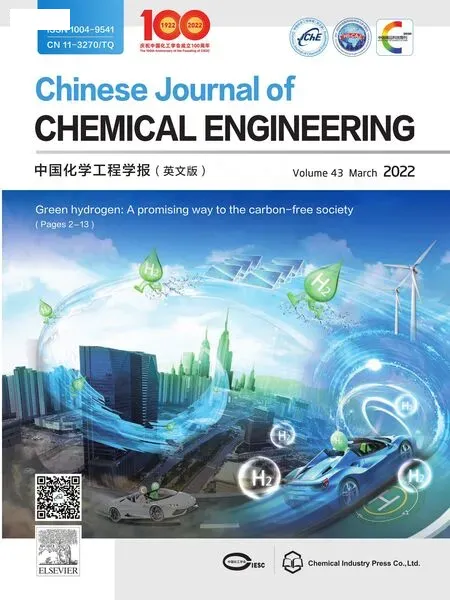
2022年3期
刊物介绍
The Chinese Journal of Chemical Engineering (Bimonthly, started in 1982) is the official journal of the Chemical Industry and Engineering Society of China and published by the Chemical Industry Press. The aim of the journal is to develop the international exchange of scientific and technical information in the field of chemical engineering. It publishes original research papers that cover the major advancements and achievements in chemical engineering in China as well as some articles from overseas contributors. The topics of journal include chemical engineering, chemical technology, biochemical engineering, energy and environmental engineering and other relevant fields. Papers are published on the basis of their relevance to theoretical research, practical application or potential uses in the industry as Research Papers, Research Notes, Chemical Engineering Data and Reviews. Prominent domestic and overseas chemical experts and scholars have been invited to form an International Advisory Board and the Editorial Committee. It enjoys recognition among Chinese academia and industry as a reliable source of information of what is going on in chemical engineering research, both domestic and abroad.
Chinese Journal of Chemical Engineering
- Editorial for special issue on Carbon-neutrality Chemical Engineering
- Green hydrogen:A promising way to the carbon-free society
- Electrochemical CO2 mineralization for red mud treatment driven by hydrogen-cycled membrane electrolysis
- Fabrication of azobenzene-functionalized porous polymers for selective CO2 capture
- Significantly enhanced charge transfer efficiency and surface reaction on NiP2/g-C3N4 heterojunction for photocatalytic hydrogen evolution
- CO2 capture by double metal modified CaO-based sorbents from pyrolysis gases
- Methane hydrate crystal growth on shell substrate
- Rh single atoms embedded in CeO2 nanostructure boost CO2 hydrogenation to HCOOH
- Molecular dynamic simulation of carbon dioxide,methane,and nitrogen adsorption on Faujasite zeolite
- Highly dispersed nickel boosts catalysis by Cu/SiO2 in the hydrogenation of CO2-derived ethylene carbonate to methanol and ethylene glycol
- CO2 mineralization of carbide slag for the production of light calcium carbonates
- High-energy-density gelled fuels with high stability and shear thinning performance
- Efficient homogenous catalysis of CO2 to generate cyclic carbonates by heterogenous and recyclable polypyrazoles
- Layered bismuth oxide/bismuth sulfide supported on carrageenanderived carbon for efficient carbon dioxide electroreduction to formate
- Influence of zinc state on the catalyst properties of Zn/HZSM-5 zeolite in 1-hexene aromatization and cyclohexane dehydrogenation
- Experimental study of the mass transfer behavior of carbon dioxide absorption into ternary phase change solution in a packed tower
- Cadmium-based metal-organic frameworks for high-performance electrochemical CO2 reduction to CO over wide potential range
- Covalent organic frameworks-incorporated thin film composite membranes prepared by interfacial polymerization for efficient CO2 separation
- A dual metal-organic framework strategy for synthesis of FeCo@NC bifunctional oxygen catalysts for clean energy application
- The effect of protic ionic liquids incorporation on CO2 separation performance of Pebax-based membranes
- Highly efficient subnanometer Ru-based catalyst for ammonia synthesis via an associative mechanism
- Hydrate formation from liquid CO2 in a glass beads bed
- Pyrolyzing soft template-containing poly(ionic liquid) into hierarchical N-doped porous carbon for electroreduction of carbon dioxide
- Improving ionic conductivity of polymer-based solid electrolytes for lithium metal batteries
- Auto-thermal reforming of acetic acid for hydrogen production by ZnxNiyCrOm±δ catalysts:Effect of Cr promoted Ni-Zn intermetallic compound
- Defective NH2-UiO-66 (Zr) effectively converting CO2 into cyclic carbonate under ambient pressure,solvent-free and co-catalyst-free conditions
- Fabricating amide functional group modified hyper-cross-linked adsorption resin with enhanced adsorption and recognition performance for 5-hydroxymethylfurfural adsorption via simple one-step
- Role of Ni species in ZnO supported on Silicalite-1 for efficient propane dehydrogenation
- The highly selective catalytic hydrogenation of CO2 to CO over transition metal nitrides
- Highly dispersible cerium-oxide modified Ni/SBA-15 for steam reforming of bio-mass based JP10
- CdS nanoparticles decorated hexagonal Fe2O3 nanosheets with a Z-scheme photogenerated electron transfer path for improved visible-light photocatalytic hydrogen production
- The role of diffusion in the nucleation of calcium carbonate
- Perspective of hydrogen energy and recent progress in electrocatalytic water splitting
- Progress of vanadium phosphorous oxide catalyst for n-butane selective oxidation
- The quasi-activity coefficients of non-electrolytes in aqueous solution with organic ions and its application on the phase splitting behaviors prediction for CO2 absorption
- Conformance control by a microgel in a multi-layered heterogeneous reservoir during CO2 enhanced oil recovery process
- Amine-immobilized HY zeolite for CO2 capture from hot flue gas
- The effect of different Co phase structure (FCC/HCP) on the catalytic action towards the hydrogen storage performance of MgH2
- Structural reconstruction of Sn-based metal–organic frameworks for efficient electrochemical CO2 reduction to formate
- Top-down strategy for bamboo lignocellulose-derived carbon heterostructure with enhanced electromagnetic wave dissipation
- 3D multiphase flow simulation of Marangoni convection on reactive absorption of CO2 by monoethanolamine in microchannel
- Design and experiment of high-productivity two-stage vacuum pressure swing adsorption process for carbon capturing from dry flue gas
